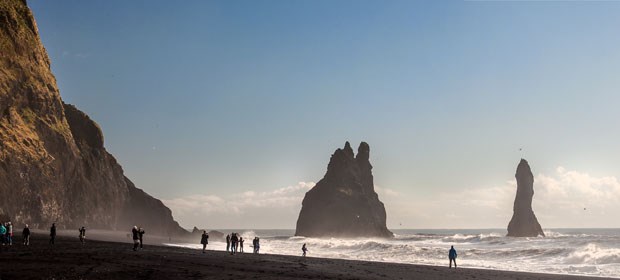When IcelandAir began flying from Canadian hubs in 2014, I took advantage of their generous stop-over policy as I flew back to Vancouver from Europe. My ten-day exploration of north and south Iceland in late-September was risky weather-wise, but I got lucky. The rich autumn colours and mostly dry sunny days were a welcome bonus in a land of unpredictable weather.
My last few days focus on southern Iceland outside Reykjavik, the capital. In a nation of intense contrasts, I plan to experience her violent and beneficial seismic activity, fire and ice, and black and whites. On arrival, I discover too the abundant co-existence of ancient and modern - a thousand-year-old parliament governs a very progressive population, and ultra-modern technologies harness their millennia-old earth energy.
Day-long guided tours for small groups prove ideal for achieving my aim. These tours in mini-buses allow spur-of-the-moment stops for photography and detours, flexibility in timing, and discussions with storytelling guides. Most importantly, the mini-buses can go where big coaches cannot.
Sharp showers pour down as I await GeoIceland's pick up at my hotel. Baldvin, our driverguide, announces, "First, I'm taking you on a detour that few get to experience." We drive east through craggy mountains on a road built to service the new hot water pipeline supplying Reykjavik. At a pull-out Baldvin, turned botanist, teaches us about the sub-Arctic flora that grows on lava. A splash of sunlight illuminates the mountainsides
in the vivid oranges of autumn beside Pingvallatn Lake.
Pingvellir may be a UNESCO World Heritage Site and a national park, but for proud Icelanders it's their national shrine. On the flat plain where the North American and Eurasian tectonic plates are pulling apart, settlers established the world's oldest, stillfunctioning parliament in 930CE. At Geysir, Iceland's most-visited geothermal field, an azure sky provides the backdrop for regular blasts of steam from Strokkur, bubbling mud pots, and scalding streams. In contrast, the Arctic wind nips my ears and nose. The afternoon brings waterfalls, big and small, including the massive Gullfoss, country roads alongside prosperous farms, and distant views of Langjökull, one of Iceland's glaciers.
After a rest day, I set off to the south shore of Iceland. Of course, showers start the day as we barrel east along Iceland's ring road, but the sun reappears at the first stop.
I confront the volcano that halted European air traffic in 2010. Today Eyjafjallajökull is benign, partly hidden by clouds, with a prosperous farm tucked below. The posters tell a different story: photos of the devastating eruption. Our guide explains, "People can be evacuated quickly, but over two hundred sheep presented difficulties. Many did not survive despite our rescue services' heroic efforts."
Near the coast, I trek to my first encounter with a glacier past piles of black gravel and rocks, all evidence of its 2,910-foot (887m) retreat since 1995.
Solheimajökull is one of Myrdalsjökull's outlet glaciers. Its lagoon is filled with small icebergs dirty with volcanic ash - I had expected clean, blue ice. The snout towers over me, breathing out cold air as if a fridge door has opened. It's criss-crossed with black veins, crevasses, and lumps of lava. Deep below Myrdalsjökull's vast icecap lies Katla, an active volcano, prompting me to ask, "What happens when the volcano grumbles?" Iceland, the land of intense contrasts, has shown me her black and white beauty, fire and ice geology, and ancient history today. I crave more but it must wait till my next stopover to Europe.
Travel Writers' Tales is an independent travel article syndicate that offers professionally written travel articles to newspaper editors and publishers. Visit www.travelwriterstales.com.



